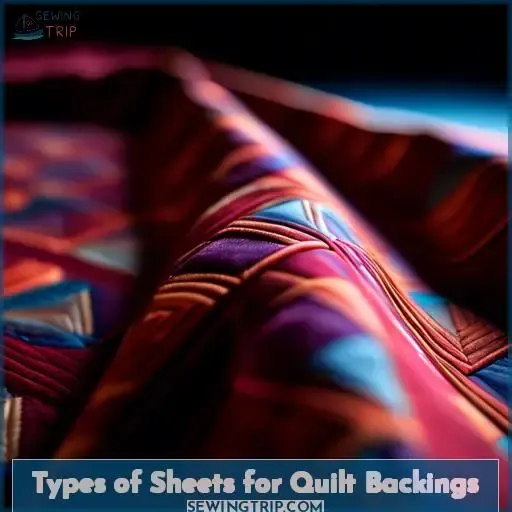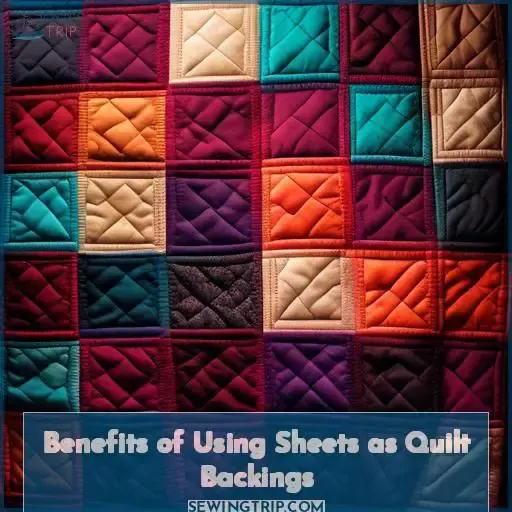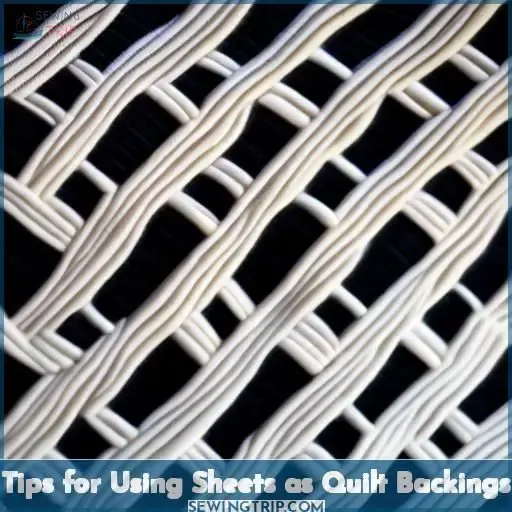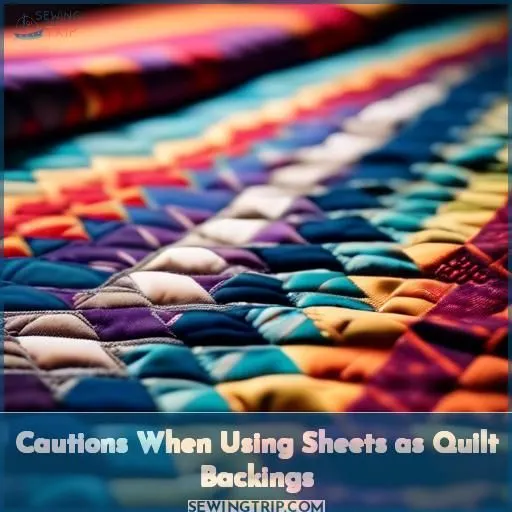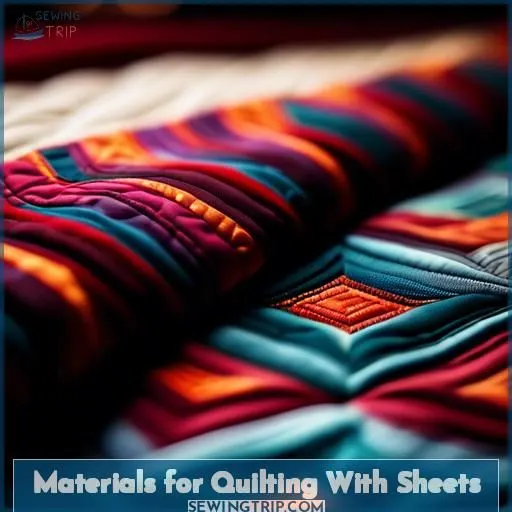This site is supported by our readers. We may earn a commission, at no cost to you, if you purchase through links.
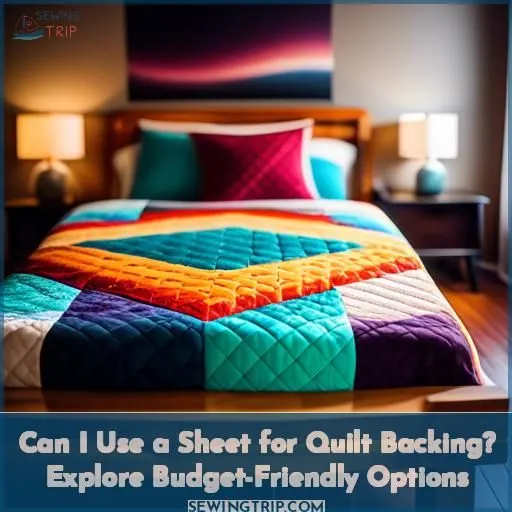 Budget-friendly quilters, listen up!
Budget-friendly quilters, listen up!
Using sheets as quilt backing is a cost-effective solution you can’t ignore.
With the right approach, you’ll create beautiful quilts without breaking the bank.
I’ll guide you through selecting suitable sheets, prepping them for quilting, and avoiding common pitfalls.
So you can confidently use a sheet for quilt backing.
Table Of Contents
Key Takeaways
- Lower thread counts are easier for stitching and are often recommended for quilting.
- Sheets are available in various colors and patterns, making them suitable for different types of quilts.
- Using sheets as quilt backings can save money and eliminate the need for piecing backs.
- Wash and dry sheets before quilting to prevent issues, such as bleeding or shrinking.
Types of Sheets for Quilt Backings
Diving into the cozy world of quilting, you might wonder if the humble bed sheet can double as a quilt backing.
When choosing your champion, cotton is king due to its breathability and durability.
But don’t just grab any old sheet; thread count plays a pivotal role.
Opt for lower thread counts for easier stitching, steering clear of those slippery, wrinkle-free types.
Flannel sheets whisper sweet nothings to winter quilts, offering extra warmth.
While duvet covers are the unsung heroes, providing ample fabric for larger projects.
So, next time you’re sheet shopping, keep these tips in your quilter’s toolkit for a match made in heaven.
Benefits of Using Sheets as Quilt Backings
Using flat sheets as quilt backings has several benefits:
They are cost-effective.
They are easy to purchase.
They come in a wide variety of colors and patterns.
They can be used with different types of quilts.
Lower thread count sheets work best.
Cotton/polyester blends can also be effective.
It’s essential to wash and dry sheets before using them to prevent bleeding and shrinking.
Regular, brushed cotton, or flannel sheets can be used.
Shopping for sheets after the school year starts or after Christmas can yield great deals.
Thread count considerations
Thread Count Considerations: The Importance of Choosing the Right Sheet for Quilt Backing
When it comes to using sheets as quilt backings, thread count plays a crucial role in determining the quality and suitability of the fabric.
-
Quality and Durability: Higher thread counts generally result in more durable fabrics, as there are more threads per square inch. However, this can also make the fabric more difficult to work with, especially for hand quilting. Lower thread counts may be easier to handle but may not be as sturdy or resistant to wear and tear.
-
Batting and Weave: Thread count can affect how well the batting shows through the fabric. A higher thread count can help hide the batting, while a lower thread count may allow it to show more. Additionally, an even weave is generally easier to work with when quilting, as it provides a consistent give in both directions.
-
Shopping Tips: Keep in mind that thread count isn’t the only factor to consider when selecting sheets for quilt backing. Quality, material, and care instructions are also important. For example, bed sheets made of 100% cotton with a thread count of around 200-600 are often recommended for quilting, as they strike a good balance between durability and ease of use.
Sheet types for quilt backing
100% cotton sheets are a popular choice for quilt backings due to their affordability and versatility.
They come in a wide variety of colors and patterns, making them suitable for different types of quilts.
Lower thread count sheets work best.
You can experiment with different thread counts and materials.
Remember to wash and dry your sheets before using them to avoid wrinkles and potential issues with shrinkage.
Shopping tips for sheets
When shopping for sheets to use as quilt backings, it’s essential to consider the thread count.
Comparing the durability of bed sheets, flannel sheets, and duvet covers can help you choose the right material for your quilt.
Washing and drying sheets before use is crucial. Using a needle size of 80/12 or 90/14 and Aurifil 50 wt cotton thread can enhance the quilting process.
Exploring vintage sheets can be rewarding, but be aware of potential issues like polyester content and shrinkage.
Tips for Using Sheets as Quilt Backings
Tips for Using Sheets as Quilt Backings
Using sheets as quilt backings can be a budget-friendly and convenient option, but there are a few tips to keep in mind to ensure a successful project.
- Shop smart: Shop for sheets after the school year starts or after Christmas when prices are lower. Look for sales and discounts to save even more money.
- Choose the right sheet type: Use a full-size flat sheet for a twin-sized quilt, and experiment with different thread counts and materials to find what works best for your project.
- Prepare your sheets: Wash and dry your sheets before using them in your quilt to minimize shrinkage and avoid any potential issues. If you’re using flannel sheets, prewash them and be aware that they may shrink up to 10% initially.
Cautions When Using Sheets as Quilt Backings
When it comes to using sheets as quilt backings, there are a few cautions to keep in mind.
High thread count sheets can pose challenges, especially for hand quilting, as they may be difficult to pierce with a needle.
Additionally, wrinkle-free sheets might have a coating that makes them tricky to quilt.
Some sheets could bleed or shrink if not washed and dried before use.
While many people have successfully used sheets for quilt backs, it’s essential to be aware of these potential issues and take precautions like washing and prepping the sheets appropriately.
Materials for Quilting With Sheets
Yes, you can use a sheet for quilt backing. Here are some reasons to use flat sheets as quilt backings:
- Dislike piecing quilt backs: Sheets are large enough to back a quilt without the need for piecing, saving you time and effort.
- Reduce costs: Sheets are more budget-friendly than quilting cotton, making them a cost-effective option for quilt backings.
- Easy to find and purchase: Sheets are widely available and easy to find in various colors and patterns.
- Wide variety of colors and patterns: Sheets come in a wide range of colors and patterns, allowing you to choose the perfect match for your quilt.
- Can be used with different types of quilts: Sheets can be used for various types of quilts, including baby quilts, wall hangings, and larger lap quilts.
When using sheets as quilt backings, consider the following tips:
- Lower thread count sheets work best: Aim for sheets with a thread count around 200 or less for easier sewing and quilting.
- Avoid wrinkle-free sheets: Wrinkle-free sheets may have a coating that makes them difficult to quilt.
- Cotton/polyester blends can work well: Look for sheets made of cotton/polyester blends, as they can provide a good balance between durability and ease of quilting.
- Wash and dry sheets before using: Pre-washing sheets helps to prevent shrinkage and bleeding during the quilting process.
- Use regular, brushed cotton, or flannel sheets: These types of sheets are generally easier to quilt through than other materials.
When shopping for sheets, consider buying after the school year starts or after Christmas when there are often sales on bedding. For a twin-sized quilt, use a full-size flat sheet. Experiment with different thread counts and materials to find what works best for your quilting machine and personal preferences.
Use a needle size of 80/12 or 90/14 and Aurifil 50 wt cotton thread for quilting.
Keep in mind that longarm machines may not work well with sheet backings, and high thread count sheets can be difficult to pierce with a needle. Wrinkle-free sheets may have a coating that makes them difficult to quilt, and some sheets may bleed or shrink if not washed and dried before use.
Bed sheets, flannel sheets, and duvet covers can all be used as quilt backings. When buying sheets for quilt backs, look for 100% cotton sheets with a low thread count (around 200 or less) and avoid microfiber or polyester sheets, as they can be difficult to baste and may slip and slide during quilting.
Thrift stores can be a great place to find unique bed sheets for quilt backings.
Quilts with sheet backings have held up well over time, and sheets have been successfully used on both Singer and Bernina sewing machines. Quilts with sheet backings have been washed and dried multiple times without issue.
Frequently Asked Questions (FAQs)
What are the best brands for sheets to use as quilt backings?
The best sheet brands for quilt backing are thrifted or discount store finds. Look for 100% cotton with a low thread count under
How do you wash and dry sheets before using them as quilt backings?
You’ll want to wash and dry those sheets before quilting with them. Run them through a normal wash cycle with detergent, then dry completely.
Can you use high thread count sheets for quilt backings?
You can, but high thread counts make it tougher to pierce with a needle. Stick to lower counts around 200 for an easier quilting experience.
What is the best needle size for quilting with sheet backings?
Quilting with sheets? No sweat! Use a needle size of 80/12 or 90/14 to easily glide through that fabric like a hot knife through butter.
Can you use sheets with a coating for quilt backings?
You’ll want to avoid sheets with coatings or wrinkle-free treatments for quilt backings. The coatings can gum up your needle and make quilting difficult. Stick with regular, 100% cotton sheets for best results.
Conclusion
As the saying goes, Little by little, one travels far. With the tips shared, you can confidently use a sheet for quilt backing and create beautiful quilts on a budget. Carefully selecting suitable sheets and properly prepping them ensures your quilts turn out fabulous without breaking the bank.

